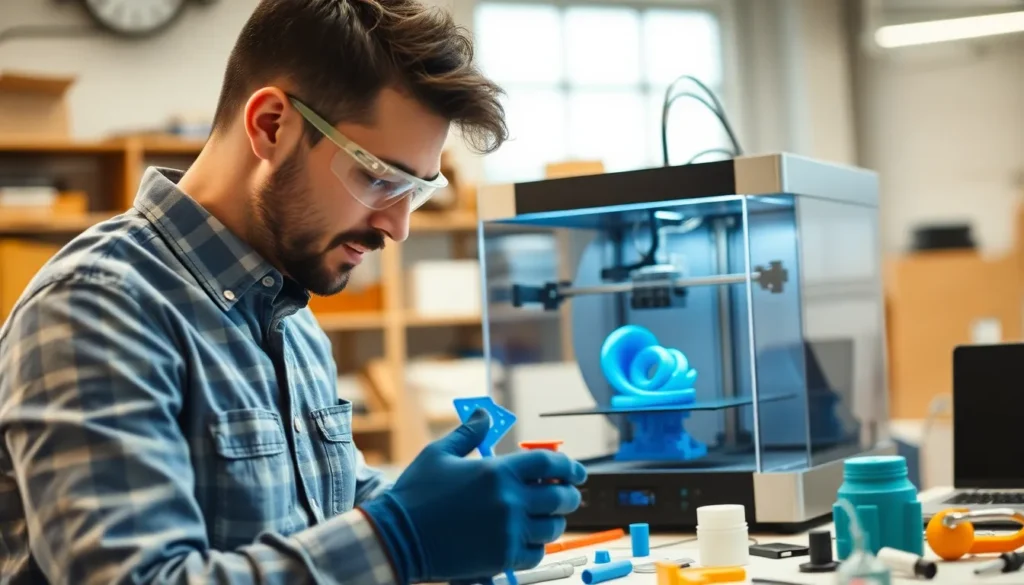Table of Contents
ToggleIn the world of 3D printing, the right software can make or break your masterpiece. Imagine crafting a stunning sculpture only to find your software’s as helpful as a chocolate teapot. With so many options out there, choosing the perfect 3D printer software can feel like trying to find a needle in a haystack—blindfolded.
Overview of 3D Printer Software
Selecting effective 3D printer software is crucial for achieving high-quality prints. Numerous options exist, each catering to different skill levels and project requirements. Some software types focus on design, while others excel in slicing or printer management.
Popular design software includes Autodesk Fusion 360 and Blender, which provide extensive modeling tools. Fusion 360 caters to mechanical engineers, offering parametric modeling. Blender, on the other hand, serves artists and animators with its sculpting capabilities.
Slicing software transforms models into instructions for the 3D printer. Spark and Cura are notable examples that support various printers and filament types. Spark offers seamless integration with Ultimaker printers, ensuring optimal settings. Cura is open-source, giving users extensive customization options.
Management software facilitates monitoring and controlling printers remotely. OctoPrint stands out as a powerful tool that offers real-time monitoring and webcam support. Users can also schedule prints and adjust settings via web interface, enhancing efficiency.
Compatibility plays a significant role in software choice. Ensuring software works with specific 3D printers and intended materials is essential. Advanced users often prefer software that allows fine-tuning of settings for unique projects.
Pricing varies widely among 3D printer software options. Free options like Cura and Blender appeal to hobbyists and beginners. Professional software such as SolidWorks comes at a premium but offers comprehensive features for serious designers.
An array of 3D printer software options exists, each with unique strengths. Choosing appropriately can greatly influence printing experiences and outcomes. Prioritizing unique project needs simplifies the selection process.
Popular 3D Printer Software Options
Selecting the right 3D printer software can transform a project. Several options stand out based on features and user requirements.
Software A Features and Benefits
Autodesk Fusion 360 excels in providing a comprehensive suite for mechanical design. Users appreciate its parametric modeling capabilities, which allow for iterative design changes. Collaboration tools within the software enable teams to work seamlessly across locations. The integration of simulation features enhances testing for mechanical properties before printing. Its cloud storage ensures access to projects from anywhere, making it convenient for designers.
Software B Features and Benefits
Blender serves artists and animators with robust modeling and animation capabilities. It’s an open-source option, allowing for extensive customization. Users find the community support invaluable for sharing resources and tutorials. Extensive add-ons expand functionality, catering to specific artistic needs. Compatibility with various file formats ensures versatility in workflows, allowing users to import and export models with ease.
Software C Features and Benefits
Cura stands out as a popular slicing software, primarily known for its user-friendly interface. Customization options allow users to tweak print settings based on specific materials and printer models. Its open-source nature fosters continuous enhancements from a global community of contributors. Integration with various printers provides flexibility for different printing environments. Users often highlight its efficient print speed and high-quality output as major advantages.
Performance Analysis
Analyzing performance metrics provides insights into 3D printer software. Factors such as speed, efficiency, and print quality play crucial roles in the overall printing experience.
Speed and Efficiency
Speed varies significantly among software options. Slicing software like Cura stands out due to its rapid processing capabilities, translating designs into printer instructions swiftly. Efficient software minimizes delays, allowing users to initiate prints quickly. The time taken for slicing often directly impacts project timelines. Additionally, many software tools offer background processing, enabling simultaneous tasks and reducing idle time. Users benefit from these features, especially in high-volume printing environments. Software compatibility with hardware also influences processing speeds, ensuring optimal performance across different printers.
Print Quality
Print quality hinges on software capability. 3D printer software affects layer adhesion and detail retention, both critical for high-quality prints. Autodesk Fusion 360 excels in detailed modeling, facilitating designs that translate effectively during printing. Blender’s versatile rendering options enhance surface finishes, delivering impressive aesthetics. Moreover, the slicing software selected can modify print settings to address specific material properties. Advanced features like adaptive layer height in Cura improve surface finish while reducing printing time. Print quality maintains a strong correlation with the software’s settings and the user’s expertise in utilizing those settings effectively.
User Experience
User experience plays a critical role in selecting 3D printer software. Effective software not only enhances the printing process but also impacts overall project quality.
Interface and Usability
A clear interface improves usability, making software easier to navigate. Autodesk Fusion 360 features intuitive design tools that streamline the modeling process, while Blender impresses with its customizable workspace. Cura stands out for its user-friendly slicing interface, which allows both beginners and experts to operate efficiently. Rapid access to essential functions within these applications aids in reducing mistakes and maximizing productivity. Smooth workflows are critical for maintaining a steady printing pace, particularly in fast-paced environments. User-friendly features, such as drag-and-drop capabilities and guided tutorials, enhance accessibility across all experience levels.
Support and Community
Strong community support significantly benefits users. Autodesk Fusion 360 offers extensive documentation along with forums, where users share tips and troubleshoot issues together. Blender benefits from a vibrant community, filled with tutorials that cover everything from basic modeling to advanced techniques. Cura maintains an active forum for users to discuss printing challenges and share custom profiles. Access to resources improves the learning curve, enabling users to navigate software more smoothly. Prompt assistance through active community engagement fosters confidence in users, encouraging experimentation and creative projects.
Pricing Comparison
The pricing of 3D printer software varies significantly across different options. Free tools like Cura and Blender offer robust functionalities without any cost. Users opting for these programs can access many features suitable for personal and professional projects.
Paid software generally provides advanced features and dedicated support. Autodesk Fusion 360, priced at approximately $495 per year, is popular among mechanical engineers due to its extensive design capabilities. SolidWorks stands out with a higher price point starting at around $3,995 for a perpetual license, catering specifically to professional engineers and designers seeking comprehensive tools.
Slicing software also presents various pricing tiers. Cura, as an open-source option, allows users to customize extensively without financial commitment. Linocour, another slicing software, costs around $199 but includes additional features aimed at improving print quality and efficiency.
Management software, like OctoPrint, remains budget-friendly while enhancing printer monitoring. Free versions exist, however, premium features can range from $20 to $150 depending on added functionalities and licenses. The balance between cost and features remains essential in selecting the right software.
The overall value of software combines pricing, capabilities, and user needs. Investing in premium options can yield better outcomes in complex projects. Understanding pricing helps users make informed choices tailored to their specific requirements in 3D printing.
Conclusion
Choosing the right 3D printer software is crucial for anyone looking to achieve high-quality prints. With a variety of options available ranging from design to slicing and management software, each serves a unique purpose that can significantly influence the printing experience.
Understanding the specific needs of projects and the compatibility of software with different printers and materials can lead to better outcomes. Whether opting for free tools or investing in premium options, it’s essential to weigh the features against costs.
Ultimately, the right software not only enhances print quality but also streamlines the entire 3D printing process, making it a vital component for success in any printing endeavor.




